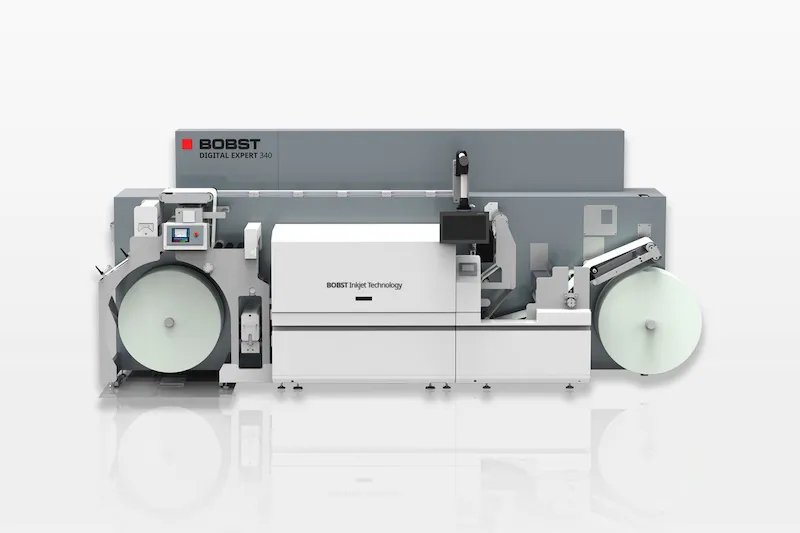
Bobst used last week’s Label Expo show to announce a new digital label press, the Digital Expert 340, but chose not to show it, opting instead to demonstrate the larger Digital Master 340 that was announced last year.
Matteo Cardinotti, pictured above, who heads up Bobst’s narrow and mid web division, says that this is because the new DE340 is a relatively simple roll-to-roll machine with the same digital print engine as the modular DM 340. Essentially, Bobst has adopted a modular approach so that customers can specify what configuration they need. For the Digital Expert machines customers can choose to have just the inkjet print module or add a flexo unit. This is exactly the same as the Digital Master except that it has a bigger chassis to accommodate more units, but it uses the same inkjet and flexo units. It’s also worth noting that there is a wider 510 mm version of the Digital Master hybrid.

Image Bobst
The only other difference is that the base model of the Digital Expert starts with a maximum running speed of 65 meters per minute at 1200 dpi resolution. This can be upgraded to the same 100 meters per minute, also at 1200 dpi, as the Digital Master through a license to unlock the software. Cardinotti explained, “The entry level speed is limited to lower the investment cost of the machine. The market is big worldwide so for some companies 65 meters per minute will be enough to replace a technology that is slower.”
He adds that on the hybrid machine 100 mpm is fast enough to be a viable alternative for a flexo press for the labels and packaging markets. He says that the choice between flexo and hybrid depends on the market and application but notes, “I would say that the hybrid is more popular now. It’s newer.”
Otherwise both presses use the same inkjet unit complete with Fujifilm Dimatix Samba print heads. They can be configured with up to six colors plus two white channels. This allows customers to add orange and violet to achieve a wider gamut. Cardinotti says, “Not many people want green. You are using a lot of heads to just add two percent gamut.”
Bobst also demonstrated a second inkjet module on the Digital Master hybrid press, located immediately in front of the standard inkjet unit. This contains additional printheads to add more white channels. Bobst is claiming that it can achieve 72% white opacity at 100 mpm, rising to 80% opacity at 80 mpm. Cardinotti adds, “It’s our aim to add additional enhancements to the double white print such as varnish.”

Cardinotti told me, “I believe that the market is moving towards hybrid. The machine in this configuration has two advantages. Doing everything in one pass reduces the need to have more operators, less waste and also the fact that it’s an inkjet that can run at 100 mpm. In the past we would have needed a finishing for multiple processes. But now the printing and converting can run at the same speed.”
He added, “And with this machine you can take jobs from really short runs and from flexo so we do believe that this configuration fits better. This doesn’t mean that the roll-to-roll is dead because many companies already have finishing and they will need to update their printing for a while.”
New UV inks and water-based ink development
Bobst will introduce a new UV inkset early next year, which Cardinotti says is driven by regulatory pressure to remove certain elements from the inks. Thus the new inks do not use TPO photoinitiators. Bobst does not make its own inkjet ink and won’t say who does.
The Digital Expert 340 replaces the older Mouvent LB702 inkjet press that Bobst launched back in 2017. Mouvent had also developed a narrower 170 mm wide press, the LB701, but Cardinotti says that Bobst has not yet decided if this will also be discontinued. He adds that Mouvent has been totally integrated into Bobst since 2020 and that Bobst has discontinued Mouvent’s range of textile printers.
Mouvent had previously shown off a version of its LB702 inkjet label press with water-based inks. Cardinotti says that Bobst is still actively working on developing a label press with water-based inks but that this is not ready yet.
Besides the hybrid press, Bobst also showed off a fully automated Master M6 flexo press, complete with Bobst’s V-Flower printing units for automatic changeovers of the print cylinders without stopping the press, which saves both time and waste.
You can find further details on Bobst’s range of digital and hybrid presses from bobst.com.
First published by www.nessancleary.co.uk on 18 September 2023. Republished by permission.










